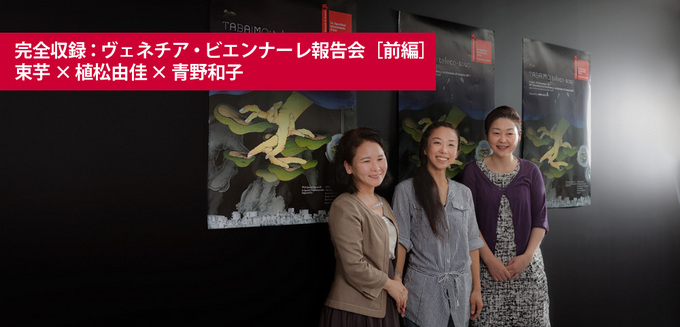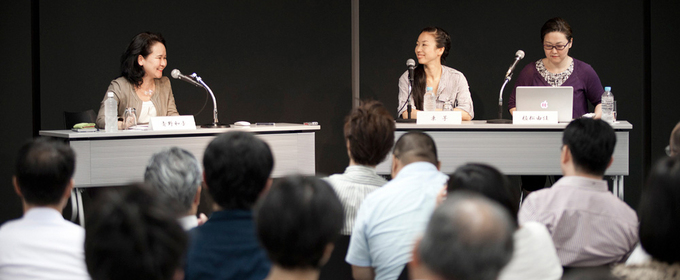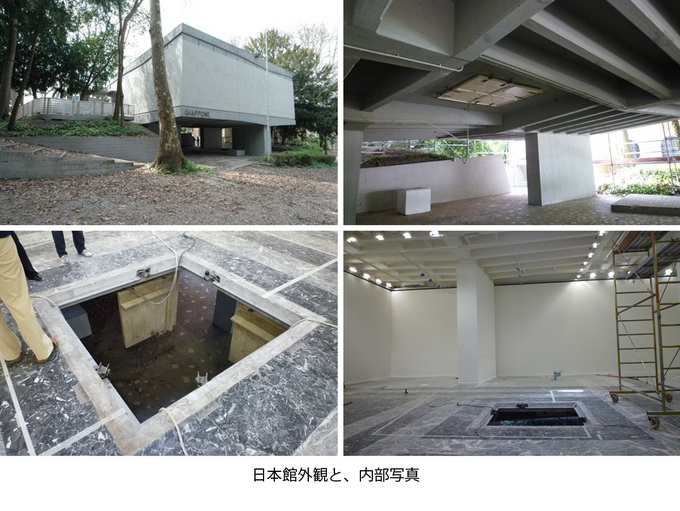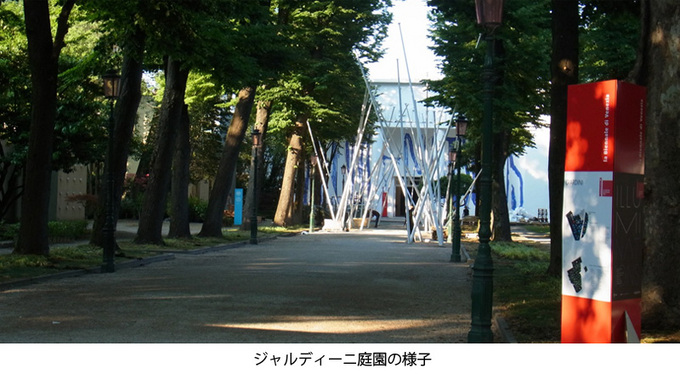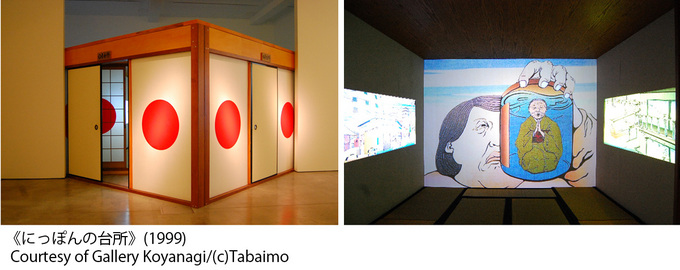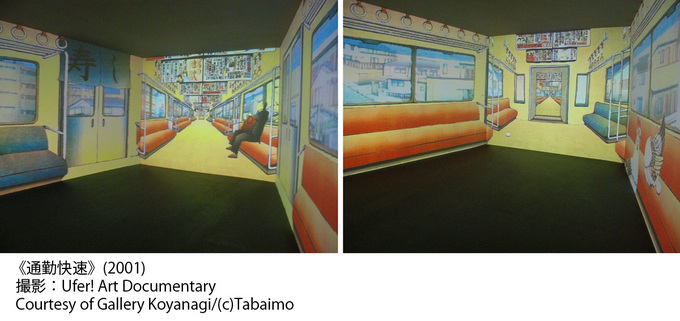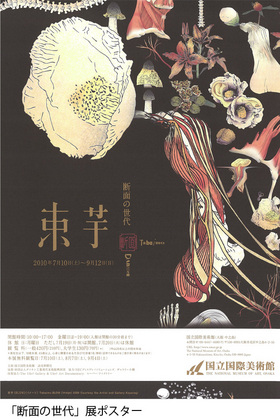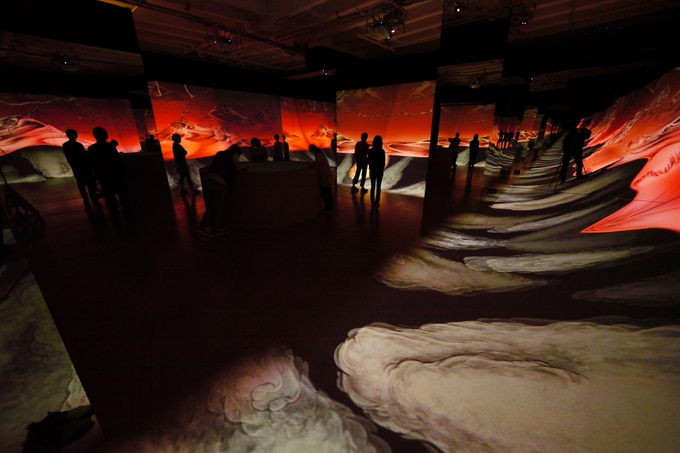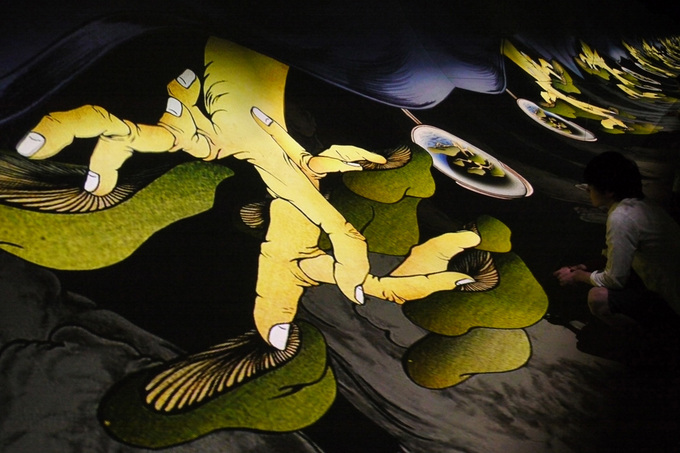Tabaimo on Venice Biennale: A Complete Report (Part I)
The Venice Biennale, held in Italy every two years, is the world's oldest and biggest art exhibition, "the Olympics" in the field of art. In 2011, a milestone year that marked the 150th anniversary of Italy's unification, the largest number of countries is participating in this exhibition of contemporary art. The venue is crowded as it has never been before. The artist in the Japanese Pavilion is Tabaimo. She is showcasing a giant installation that has turned the entire pavilion into one piece of art. In the September issue of Wochikochi Magazine, the top story is the complete report on the biennale she presented on August 9 following her return to Japan. Part I (released on September 5) carries a report on the exhibition by Tabaimo as well as by Yuka Uematsu, the curator at the National Museum of Art, Osaka, who serves as the commissioner of the Japanese Pavilion. In Part II, we have invited Kazuko Aono, who was in charge of the YOROYORON Tabaimo exhibition, to talk about what she and Tabaimo think of the work at the Japanese Pavilion and what is happening at the biennale.
At the Giardini, where the pavilions of other mighty nations stood, the Japanese Pavilion was like a frog tossed into the big ocean
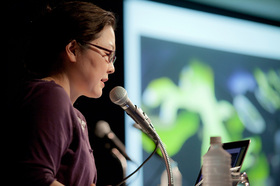 UEMATSU: I work as the commissioner of the Japanese Pavilion at the 54th Venice Biennale now being held in Italy. Some of you may have already seen Tabaimo's work, some may have become interested in the exhibition through media reports, while others may be going to Venice in the future. In any case, I think this is an excellent opportunity for Tabaimo to talk about the biennale and especially about the Japanese Pavilion.
UEMATSU: I work as the commissioner of the Japanese Pavilion at the 54th Venice Biennale now being held in Italy. Some of you may have already seen Tabaimo's work, some may have become interested in the exhibition through media reports, while others may be going to Venice in the future. In any case, I think this is an excellent opportunity for Tabaimo to talk about the biennale and especially about the Japanese Pavilion.
Originally, the title of the exhibition, as announced at a press conference at the Japan Foundation in July last year, was "Beyond Galapagos Syndrome." I would like to begin by discussing how that has evolved into teleco-soup, the final title.
teleco-soup uses the interior of the exhibition hall as well as the stilts underneath the building, in other words, the entire Japanese Pavilion. The Japanese Pavilion was designed and built in 1956. It is a building with a history of more than 50 years. Parts of the pavilion are in disrepair and, because it is a unique structure, it's rather difficult to display art works inside.
There are big holes in the ceiling and floor. Takamasa Yoshizaka, the architect, built the pavilion on the concept that it is a space to be shared by nature and art. Yoshizaka imagined that winds would blow through the holes in the ceiling and floor and rain might also come in at times. This is a unique architectural idea. At the same time, however, it presents many difficulties when it comes to holding exhibitions. So, since 2010 when I was nominated as commissioner, I handed a blueprint of the building and some photos to Tabaimo and we have been discussing exactly what sort of exhibition we would want to hold.
In the process, Tabaimo came up with the concept, "Is the world of a frog living in the well really so small?" Confucius says, "A frog in a well cannot conceive of the ocean." But Tabaimo embraced the idea that, though the well might look small inside, a vast world might stretch on and on in reality down there and that?this part is said to have been added later in Japan?"it knows the height of the sky." She assumed that the hole in the floor is a well that rises to touch the sky and the interior of the exhibition hall represents the inside of the well. She envisioned the creation of a world that is upside down. In other words, it's based on the concept of abekobe, or the wrong way round, with the hole and the exhibition space turned upside down.
At the same time, Tabaimo and I had a series of discussions about the Giardini, the park where the Japanese Pavilion is located. In the Giardini, one of the main exhibition sites at the Venice Biennale, there are also pavilions of other countries like Britain, Germany, South Korea, France and the United States. This place is just like a microcosm of the kind of world that symbolized the relations among the great powers in the 1910s through the 1930s. In a way, Japan in Venice is like a frog that has been thrown into the great ocean.
People often say these days that Japan is trapped in the "Galapagos Syndrome." As an example, they cite Made-in-Japan cell phones that haven't gone anywhere in the global market despite the constant technological progress the country has made in recent years. But we thought we might be able to break through this condition by further fostering and fully developing Japan's traditional culture, like anime and Ukiyo-e woodblock prints, for example, or that we might be able to redraw the image of Japan and the Japanese whom people in other countries often compare to that frog in the well. This idea led to the title "Beyond Galapagos Syndrome" announced at the first press conference.
Creating a kaleidoscopic world through the imaginative use of 18 projectors
As you all know, Tabaimo creates animation using several thousand drawings in Ukiyoe-style colors and presents them as image installations. This element of "installation" is important when we discuss her works. Her 1999 work Japanese Kitchen, her sensational debut piece, shows space in the shape of a typical Japanese house in which three-sided images flow. Likewise, Japanese Commuter Train, the work she introduced at Yokohama Triennale 2001, made effective use of space by projecting images like a miniature garden across a train aisle. Last year, she also held one of her biggest personal exhibitions, Tabaimo: DANMEN at the Yokoyama Museum of Art (Kanagawa) and the National Museum of Art (Osaka), drastically changing exhibition plans for each museum even as she showed the same works, paying the closest attention to how to display her works. Her meticulous attention to the use of space is carried over to the Venice Biennale.
A total of 18 projectors are used this time, 12 inside and 6 outside the pavilion. A three-sided main screen and temporary partitions surrounding the four walls are set up inside the pavilion and mirrors are imbedded on the surface of these partitions. When you step into the pavilion, you see the images of yourself reflected in these mirrors and find yourself enveloped in a kaleidoscopic world.
Many of the prepared images are familiar to those of you who have already seen her works, like the scene of flowers blossoming and Japanese houses in the background. In the Venice exhibition, there are many scenes in which the images Tabaimo has created to date are used in an impressive way, and many people think these images represent a culmination of all the works she has done to this day. But if I am allowed to borrow her words, this exhibition not only brings her past works together, but it also symbolizes the process of reviewing the trunks and roots in her world of art that has spread like branches and leaves until now. teleco-soup means a new world that connects with the past even as it continues to develop today.
Boltanski drops in on the Japanese Pavilion
Let me talk a little here about what is happening at other pavilions. The German Pavilion, which won the Golden Lion for best national participation, was featuring an installation which recreated the stage in the play A Church of Fear vs. the Alien Within by Christoph Schlingensief, who passed away last autumn. Originally, Germany had planned to show a work Schlingensief had been working on until shortly before his death, but Commissioner Susanne Gaensheimer thought it would be difficult to display the original work in the absence of its writer and decided instead on an exhibition that would commemorate Schlingensief's artistic life.
The Clock by Christian Marclay, who was awarded the Golden Lion for the best artist at the ILLUMInations Exhibition, is also on display now at Yokohama Triennale 2011 and you may have an opportunity to see it. The exhibition puts together scenes related to clocks and time from various movies and creates clocks through images. The time in those images and in our real world passes in tandem for 24 hours.
The French Pavilion displayed the works of Christian Boltanski. The artist himself stopped by at our pavilion toward the end of May, around the time we were wrapping up our preparations for the opening of the exhibition. Seeing our work he commented that there are many great installations at the Venice Biennale, though materials and expression patterns are different from artist to artist. Looking back, I would say there are many fine installations at the biennale this time, like those of Thomas Hirschhorn in the Swiss Pavilion and Jennifer Allora and Guillermo Calzadilla in the American Pavilion. I think this whole trend and Tabaimo's installation are connected somewhere.
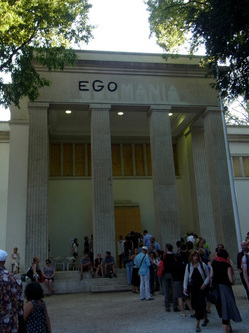
German Pavilion, which exhibited the theatrical installation of Christoph Schlingenseif, who passed away at age 49
http://www.schlingensief.com/index_eng.html
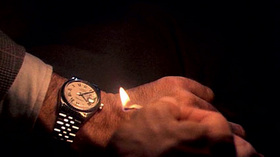
Christian Marclay
The Clock
2010
Single channel video
Duration: 24 hours
(c) the artist Courtesy White Cube
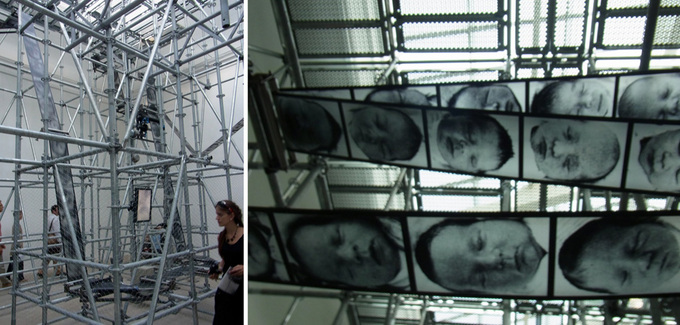
Christian Boltanski's Chance at the French Pavilion
Belts with the faces of scores of babies printed on them continue to turn. Does this space signify the cycle of life and death?
http://www.boltanski-chance.com/
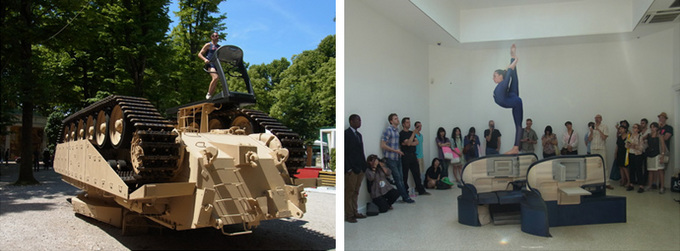
Track and Field (left) and Body in Flight (DELTA) (right) by Allora and Calzadilla at the US Pavilion
Considering the caterpillar track of a tank as a running machine and first-class seats of an airplane as a balance beam, real Olympic athletes performed on the first day of the exhibition.
http://www.imamuseum.org/venice/
The walls, the greatest hurdle, turned into an indispensable friend
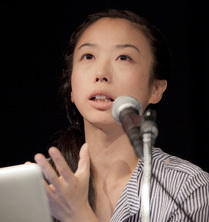 TABAIMO: The first thing I thought about after I was chosen as representative for the biennale was what sort of place the Japanese Pavilion should be.
TABAIMO: The first thing I thought about after I was chosen as representative for the biennale was what sort of place the Japanese Pavilion should be.
You know this if you have visited the pavilion; but the big challenge was what to do with those four walls and the gaping hole in the center that no one can move. I thought right away that I have to make effective use of the walls and the hole. Unless I cleared this hurdle, I thought, a truly fine installation would be impossible. In the end, the walls and the hole proved to be essential for the success of the exhibition. As it turned out, they were really a friend I could always count on, not an enemy.
As you can see from the model of the exhibition, the mirrors are positioned in such a way that they cover the walls stretching out toward the center and long screens are set up between these walls. In the work BLOW in the DANMEN exhibition, curving screens looking like the sloping floors we often see at a skateboard park were built on both sides of the passage, and mirrors were placed beside the entrance and the exit, leaving the impression that images go on and on. What we have done this time is an extension of this model.
You can see images projected on three screens as well as those reflected in the mirrors. And if you look through the hole in the center, you can also see images on a tube-shaped screen. In addition, you can see images from outside the stilts. The exhibition uses both the interior and exterior of the pavilion, in other words, the whole structure.
You can't really grasp the scale of the space because the images reflected in the mirrors stretch toward the back and they are also thrown back onto other mirrors. If you stand in the middle of the exhibition hall, you would have no idea what sort of images are projected, and where. This is an important element for me. I am always thinking about creating a work that will make people unsure where they are standing or what they are looking at. I drive in a stake to make it the center of my work, then pull it out immediately and pound another stake in. Through this process I am always trying to shift the center.
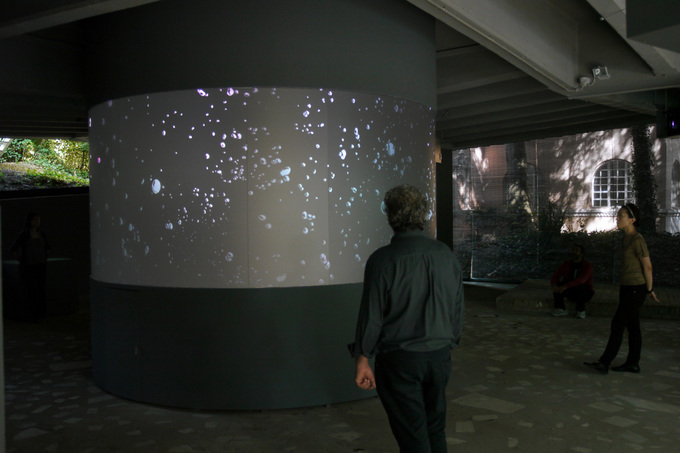
teleco-scope by Tabaimo: Scene at the Japanese Pavilion, the 54th Venice Biennale, 2011
(c) Tabaimo / Courtesy of Gallery Koyanagi and James Cohan Gallery
Photo: Ufer!
Sharing responsibility half-and-half with viewers leads works to completion
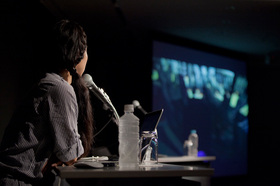 The title teleco-soup comes from a combination of "telescope" and tereko, a word in the Kansai dialect that means abekobe, or "the wrong way round." I have always been interested in things that have nested structures. When I am working, I imagine myself at the center of many worlds that spread on and on around me.
The title teleco-soup comes from a combination of "telescope" and tereko, a word in the Kansai dialect that means abekobe, or "the wrong way round." I have always been interested in things that have nested structures. When I am working, I imagine myself at the center of many worlds that spread on and on around me.
This time, I considered the entire Japanese Pavilion as a giant work of art so the moment visitors step inside they feel as if they were part of the work itself. I think they should be able to recognize this concept clearly when they see the images of my work reflected endlessly in the mirrors as well as their own images cast upon them. So this, in a sense, is also tereco, or abekobe, meaning that people who visit the pavilion to appreciate my work end up appreciating themselves in their own images. The image of soup in a soup bowl has the meaning of life-creating liquid. The title teleco-soup was born from a mixture of a variety of elements blended together.
In some of the images, viewers will feel clouds creeping in and clinging around their feet. A human brain comes rising like the sun or the moon, and the world unfurls itself in the light that appears shining from the brain. Up-and-down movements like this form the basis of the images of this work. On the other hand, the mirrors make people imagine the world spreading sideways. The intersecting movements of the images and mirrors up and down and sideways lead to a constant development of space. And the energy reflected by the mirrors continues to expand endlessly by the imagination of the viewers.
In a sense, my work requires visitors to share a large responsibility. I am always trying to present my works in perfect condition, but they become complete only when viewers involve themselves. Viewers and I share the responsibility 50-50 in order to lead my art works to completion. That mutual relationship forms the core of my works. So this exhibition should always be perfect, regardless of when it is seen during the six months it lasts.
I have repeatedly talked with the local staff about what we need to do to keep the exhibition in the best condition. Because I am hoping that viewers can appreciate my work in perfect condition, I would like to deal perfectly with any trouble that may come up. I was putting the exhibition together hoping more than anything that, once I cleared this hurdle, viewers would understand and appreciate the essence of my work when they visit the pavilion.
Photo: Kenichi Aikawa
Dust swirling up at the Giardini...the unimaginably fast deterioration of projectors.... How difficult is it to hold an exhibition in perfection condition for six months overseas, and at a place that is not an art museum? What do we find in the deep conviction of Tabaimo, who always wants to keep her works of art in their best condition? In Part II, we welcome Kazuko Aono, curator of the Hara Museum of Contemporary Art, as our guest. Part II will be released in mid-September.
JFIC Library Venice Biennale Catalog Exhibition In commemoration of the 54th Venice Biennale, the catalogs of works by Japanese artists who participated in the Japanese Pavilion exhibitions?from Kishin Shinoyama in the 37th exhibition in 1976 to Miwa Yanagi in the 53rd exhibition in 2009?are on display in the JFIC Library. You can look through the catalogs or check them out.
Date: September 5 (Mon.) - September 16 (Fri.), 10:00 - 19:00
Place: Japan Foundation JFIC Library (Yotsuya, Tokyo)
Venice Biennale Japanese Pavilion Exhibition press conference
Click here for a video clip of the press conference held in July 2010 (in Japanese)
Tabaimo
Artist representing Japan at the 54th Venice Biennale
Born in Hyogo Prefecture in 1975, Tabaimo lives in Nagano Prefecture. She graduated from Kyoto University of Art and Design in 1999. In the same year, she received the Grand Prize in the Kirin Contemporary Awards for her graduation work, Japanese Kitchen. She has held solo exhibitions at various institutions. They include the Tokyo Opera City Art Gallery (2003), the Hara Museum of Contemporary Art (Tokyo, 2006), the Cartier Foundation for Contemporary Art (Paris, 2006), the Singapore Tyler Print Institute (2010), Parasol Unit Foundation for Contemporary Art (London, 2010) and Tabaimo: DANMEN at the Yokohama Museum of Art and the National Museum of Art (2010). She has also participated in many international and group exhibitions, among them the first Yokohama Triennale (2001), the Sao Paulo Biennale (2002), the Sydney Biennale (2006) and the Venice Biennale (Italian Pavilion, 2007). She has shown her talent in various genres, including essays and book illustrations. Tabaimo also published Akunin (Villain), an illustrated book based on art illustrations she did for a serialized newspaper novel (July 2010, Asahi Shimbun Publications Inc.).
Yuka Uematsu
Commissioner, Japanese Pavilion, 54th Venice Biennale
Uematsu was born in Kagawa Prefecture. After working at the Marugame Genichiro-Inokuma Museum of Contemporary Art, she became curator at the National Museum of Art, Osaka, in October 2008. The major exhibitions she has curated include Tabaimo: DANMEN (2010, co-organized by the Yokoyama Museum of Art), Pipilotti Rist: YuYu (2008), Eija-Liisa Ahtila (2008), Mariene Dumas: Broken White (2007, co-organized with the Museum of Contemporary Art, Tokyo), Yoshihiro Suda (2006), Miwa Yanagi: Darkness of Girlhood and Brightness of Aging (2004), Marina Abramovic - The Star (2004, co-organized with the Contemporary Art Museum, Kumamoto), Yayoi Kusama - Beyond the Labyrinth (2003), Jan Fabre (2001) and Isamu Noguchi & Issey Miyake ARIZONA (1997). She served as Japanese commissioner at the 13th Bangladesh Biennale. She teaches at Kyoto University of Art and Design.
Takeshi Art Beat on NHK, October 12, 2011
A report on the Venice Biennale with an appearance by artist Tabaimo.
Related Articles
Related Events
Keywords
- Anime/Manga
- Design
- Arts/Contemporary Arts
- International Exhibition
- Japan
- Italy
- Venice Biennale
- Tabaimo
- Yuka Uematsu
- Kazuko Aono
- The Japan Foundation
- Takamasa Yoshizaka
- image installation
- Yokohama Museum of Art
- National Museum of Art Osaka
- Christoph Schlingensief
- Susanne Gaensheimer
- Christian Marclay
- Yokohama Triennale
- Christian Boltanski
- Thomas Hirschhorn
- Allora and Guillermo Calzadilla
Back Issues
- 2023.12. 7 Movie Theaters aroun…
- 2023.6.16 The 49th Japan Found…
- 2023.4.24 The 49th Japan Found…
- 2022.12.27 Living Together with…
- 2022.12.27 Living Together with…
- 2022.8.12 Inner Diversity <…
- 2022.3.31 The 48th Japan Found…
- 2022.3.29 Beyond Disasters - T…
- 2021.11.29 Crossing Borders, En…
- 2021.4.13 Crossing Borders, En…


